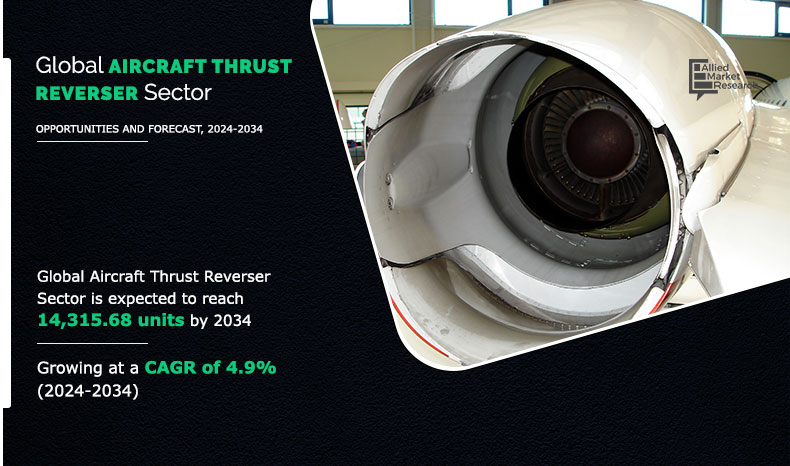Volume Insight on Aircraft Thrust Reverser Market

Allied Market Research announces the release of its comprehensive analysis of the global number of aircraft thrust reverser. An aircraft thrust reverser is a critical aerodynamic device integrated into the exhaust section of a jet engine or nacelle system. It is designed to temporarily redirect the engine’s thrust forward rather than backward during landing. It typically consists of mechanical components such as cascade vanes, blocker doors, translating cowls, or clamshell doors, depending on the engine and airframe configuration. When deployed, these systems divert the high-velocity exhaust or bypass airflow to oppose the aircraft’s forward motion, significantly enhancing deceleration during landing and reducing brake wear. Aircraft thrust reversers are especially crucial for operations on short runways, wet or icy surfaces, or at airports with limited infrastructure.
The report highlights the impact of increase in air travel, growing orders for new aircraft from developing countries, and technological advancement in the electric and hybrid aircrafts. The global aviation industry has witnessed strong growth over the past few decades owing to globalization, technological advancements, and increase in affordability of air travel. Surge in use of new aircraft for air travel is driving the demand for aircraft thrust reverser. According to a data published from the International Air Transport Association (IATA) in February 2023, there was a substantial of 55.5% increase in total air traffic globally, when compared to a data from 2022. In addition, there is also rapid growth in air travel especially in developing countries, located in the Asia-Pacific region. For instance, in 2024, according to the data by Government of India’s, Press Information Bureau, the number of operational airports in India doubled from 74 in 2014 to 157 in 2024. Moreover, the country is aiming to increase it by 350-400 by the year 2047. The aviation sector in the country has shown substantial growth of 13% YoY. The demand for air travel is expected to continue to grow in the coming decade, thus driving the growth of the aircraft thrust reverser sector volume forecast.
The strong growth in the number of aircraft thrust reverser sector volume share is attributed to increase in air travel, growing orders for new aircraft from developing regions, and technological advancement in electric and hybrid aircraft . The global volume of aircraft thrust reverser is expected to grow from 8859 units to 14315 units, registering a CAGR of 4.9% during the forecast period. This rapid expansion is also supported by increase in sales of personal aircraft and regional jets, and modernization of military aircrafts.
Regional Aircraft Thrust Reverser Volume Growth
Europe dominated the aircraft thrust reverser sector volume growth with 32% share in 2024 with a 4.8% CAGR, while North America, Asia-Pacific and LAMEA show strong growth at 5.7%, 4.8%, and 3.6% CAGR, respectively from 2025-2034, driven by increase in air travel, growing orders of new aircrafts from developing countries, and technological advancement in electric and hybrid aircrafts.
The regional analysis highlights significant variations in adoption trends and sector potential across the globe. Europe leads the aircraft thrust reverser sector share, contributing over 32% of the total volume in 2024 and expected to grow at a CAGR of 4.8%, driven by the growing political tension in Europe which has resulted in increased military spending across the region. Countries in the region have increased their spending for purchase of new aircraft and other crucial military equipment to safeguard their country. Majority of the country in European union still operate older generation of fighter aircrafts and cold war-era surveillance aircraft, Countries in Europe are prioritizing on upgrading their military aircraft fleet which are positively driving the aircraft thrust reverser sector volume trends.
Likewise, the North America sector is expected to grow at 5.7%, owing to the increase in military spending in the U.S., Canada, and Mexico. In addition, rise in geopolitical tension has lead to increased investment in modernizing military aircrafts. Moreover, the U.S. and Canda have pledged their allegiance to NATO, and also works for United Nations peace keeping mission and arctic security, which has resulted in increased need for modern aircrafts, thus driving the sector demand. The Asia-Pacific sector is expected to grow at 4.8%, owing to the presence of countries such as Thailand, Japan, Indonesia, Australia, and others which have become major tourist attractions. To tackle the growing tourism, government in the region are focusing on investing in airport infrastructure to accommodate growing passenger numbers. There are major mega projects such as Beijing Daxing International Airport, Changi Airport expansions in Singapore, and India’s Navi Mumbai International Airport. The growing investment in airport and increase in air traffic are positively driving the growth of aircraft thrust reverser sector in the region. The LAMEA region is predicted to grow at a CAGR of 3.6%, owing to rapid economic growth in Middle East and countries of Africa countries has resulted in increase demand for air travel. Moreover, with the growing number of high net worth individuals in the region has fuelled the demand for new aircrafts. Similarly, in recent years, the Middle east region has emerged as a strategic aviation destination for global aircraft operators. Middle East is experiencing rapid growth in international air traffic thus driving the demand for aircraft thrust reverser sector volume application.
Aircraft Thrust Reverser Volume Growth, By Region, 2025-2034 (000 Units)
Region | 2024 | 2028 | 2034 | CAGR (2024-2034) |
North America | 2623.14 | 3232.79 | 4560.28 | 5.7% |
Europe | 2873.83 | 3417.6 | 4572.94 | 4.8% |
Asia-Pacific | 2196.35 | 2617.84 | 3518.89 | 4.8% |
LAMEA | 1166.21 | 1329.05 | 1663.57 | 3.6% |
Total | 8859.53 | 10597.28 | 14315.68 | 4.9% |
Source: AMR Analysis
Aircraft Thrust Reverser Country Sector Sales
U.S., China, and Germany lead the aircraft thrust reverser sector volume projection, and is projected to grow at 5.6%, 4.7%, and 4.2%, respectively while Latin America (3.5% CAGR) and Middle East (2.9% CAGR) emerge as high-growth markets driven by increase in air travel, growing order of new aircrafts from developing regions, and technological advancement in the electric and hybrid aircrafts.
The report identifies U.S., China, and Germany as the largest contributors to the aircraft thrust reverser sector sales in terms of production and sales. In U.S., rise in production of aircraft is expected to positively drive the growth of the aircraft thrust reverser sector. Moreover, the county has presence of Boeing, Lockheed Martin, and Textron Aviation which are leading in the production of both commercial and military aircraft thrust reverser system. Likewise, in China, the growing air travel in China and increase demand for new aircraft drive the sector for aircraft thrust reverser sector. According to a report published by Boeing on August 26, 2024, China’s commercial fleet is expected to be more than double by 2043. According to the report the air travel in mainland China will grow 5.2% annually, thus making it the world's largest air traffic sector in coming years. The growing air travel will create demand for 8,830 new planes over next 20 years, thus driving the sector growth for aircraft thrust reverser. Moreover, in Germany being one of the world’s leading aviation and aerospace manufacturing country. Every sixth passenger aircraft operating worldwide is assembled in Germany, which account for about 17% of global aircraft production. The German aerospace industry generated a revenue of $48.2 billion in 2023, the aircraft manufacturing industry is anticipated to show string growth rate in coming years thus driving the sector for aircraft thrust reverser sector.
Emerging markets such as Latin America and Middle East are expected to drive significant growth in coming years due to the rapid growth in tourism in Latin America countries such as Peru, Chile, Caribbean, and others has resulted in increase number of travelers. To tackle the growing tourism, governments in the region are increasing their investment on developing airport infrastructure to meet growing passenger volume. Moreover, there are also major airport modernization projects such as the such as expansions of Bogotá’s El Dorado International Airport, and São Paulo’s Guarulhos Airport. The growing construction of airports has resulted in growing demand for new aircrafts thus driving the aircraft thrust reverser sector sales. Moreover, in Middle East the UAE has two globally renowned airlines operators, Emirates Airlines and Etihad Airways. Moreover, there are some small low cost operators in the region such as flydubai and Air Arabia. Dubai International Airport, is one of the world’s largest and busiest international airports. The UAE government invested heavily in airport development and expansion projects such as investment of $8.1 billion in Al Maktoum International Airport in Dubai and $6.8 billion for Abu Dhabi Airport development and expansion plans, the government in the region have also allocated around $400 million in Sharjah’s International Airport terminal expansion. Rise in number of air travel in the region offers lucrative opportunity for the growth of aircraft thrust reverser sector.
Aircraft Thrust Reverser Volume Share, By Country, 2024-2034 (000 Units)
Country | 2024 Units |
U.S. | 376.43 |
China | 196.68 |
Germany | 104.46 |
Latin America | 121.62 |
Middle East | 108.06 |
Source: AMR Analysis
Key Highlights by Stakeholders
Highlighting the significance of this report, Ashwani Ajwani, Vice-President of Allied Market Research, stated, “the increase in air travel, growing order for new aircraft from developing regions, and technological advancements in the electric and hybrid aircraft driving the aircraft thrust reverser industry..” He further added, “in Asia-Pacific, increase in sales of personal aircrafts and regional jets, as well as modernization of military aircrafts are the major factors driving the growth of aircraft thrust reverser sector.
Aircraft Thrust Reverser Volume Trends
In addition, increase in sales of personal aircrafts and regional jets, as well as modernization of military aircrafts. Advancements in aviation technology, change in consumer preferences, and surge in demand for convenience dr the sales of personal aircraft. The growing technological advancement of light jets, turboprops, and single-engine aircrafts are further driving the sales of personal aircrafts. Moreover, increase in number of billionaires and high net worth individual is further growing the sector. According to a report published by Air Charter Association, the sales of pre-owned private jet grew significantly in 2022, especially in Asia-Pacific and the Middle East region. The company also stated that pre-owned business jets has grew significantly in the last two years due to affordability of pre-owned jets. According to the report, the sales of private aircrafts is expected to continue in 2025 owing to strong economic growth in developing countries. Thus, the growing inclination toward sales of personal aircraft offers lucrative sector growth opportunity for aircraft thrust reverser sector.
Furthermore, the study discusses the potential impact of stringent certification and regulatory requirements, as well as high development and manufacturing cost impacting the growth of the sector.
Aircraft thrust reverser manufacturers and stakeholders should use the report’s insights to grab new opportunities and plans.
About Allied Market Research
Allied Market Research is a full-service market research and business consulting firm, which provides actionable insights and strategic recommendations to help clients make informed decisions and achieve sustainable growth. For more inquiries, please visit alliedmarketresearch.com


